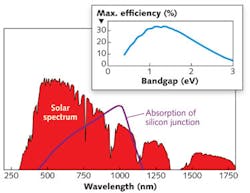Dual-junction 1-sun solar cell sets new efficiency record of 29.8%
Researchers at the Energy Department's National Renewable Energy Laboratory (NREL; Golden, CO) and at the Centre Suisse d'Electronique et Microtechnique (CSEM; Neuchâtel, Switzerland) have jointly set a new world record for converting 1-sun (nonconcentrated) sunlight into electricity using a dual-junction III-V/silicon solar cell. High-efficiency multijunction photovoltaics are a focus of research, as they allow smaller solar installations for the same amount of captured solar power.
The newly certified record conversion efficiency of 29.8% was set using a top cell made of gallium indium phosphide (GaInP) developed by NREL, and a bottom cell made of crystalline silicon developed by CSEM using silicon (Si) heterojunction technology. The two cells were made separately and then stacked by NREL. The record was published in "Solar cell efficiency tables."1
Most use of photovoltaics around the world are in a 1-sun configuration (meaning there is no use of concentrating optics), as this configuration allows for placement almost anywhere, does not require tracking the sun, and can capture some of the sun's energy even on cloudy days. Thus, the NREL/CSEM development, and similar future improvements, has the potential to be widely disseminated.
Results for stacked cell exceed theoretical limit for Si-only cells
"It's a record within this mechanically stacked category," says David Young, a senior researcher at NREL. "The performance of the dual-junction device exceeded the theoretical limit of 29.4% for crystalline silicon solar cells."
Young is co-author of a paper, "Realization of GaInP/Si dual-junction solar cells with 29.8 percent one-sun efficiency," which details the steps taken to break the previous record. His co-authors from NREL are Stephanie Essig, Myles Steiner, John Geisz, Scott Ward, Tom Moriarty, Vincenzo LaSalvia, and Pauls Stradins. The paper has been submitted for publication in the IEEE Journal of Photovoltaics.
Essig attracted interest from CSEM when she presented a paper, "Progress Towards a 30 percent Efficient GaInP/Si Tandem Solar Cell," to the 5th International Conference on Silicon Photovoltaics, in Germany in March.
"We believe that the silicon heterojunction technology is today the most efficient silicon technology for application in tandem solar cells," says Christophe Ballif, head of PV activities at CSEM.
A new design for the dual-junction solar cell and the contributions from CSEM were key to setting the record. The results further indicate that even greater efficiency can be achieved by the combination of NREL and CSEM cells.
Funding for the research came from the U.S. Department of Energy's Office of Energy Efficiency and Renewable Energy SunShot Initiative, which aims to make solar energy fully cost-competitive with traditional energy sources (energy.gov/sunshot); from the Swiss Confederation; and from the Nano-Tera.ch initiative.
Source: http://www.nrel.gov/news/press/2016/21613
REFERENCE:
1. Martin A. Green et al., Solar cell efficiency tables (version 47), 24 Nov. 2015; doi: 10.1002/pip.2728

John Wallace | Senior Technical Editor (1998-2022)
John Wallace was with Laser Focus World for nearly 25 years, retiring in late June 2022. He obtained a bachelor's degree in mechanical engineering and physics at Rutgers University and a master's in optical engineering at the University of Rochester. Before becoming an editor, John worked as an engineer at RCA, Exxon, Eastman Kodak, and GCA Corporation.
